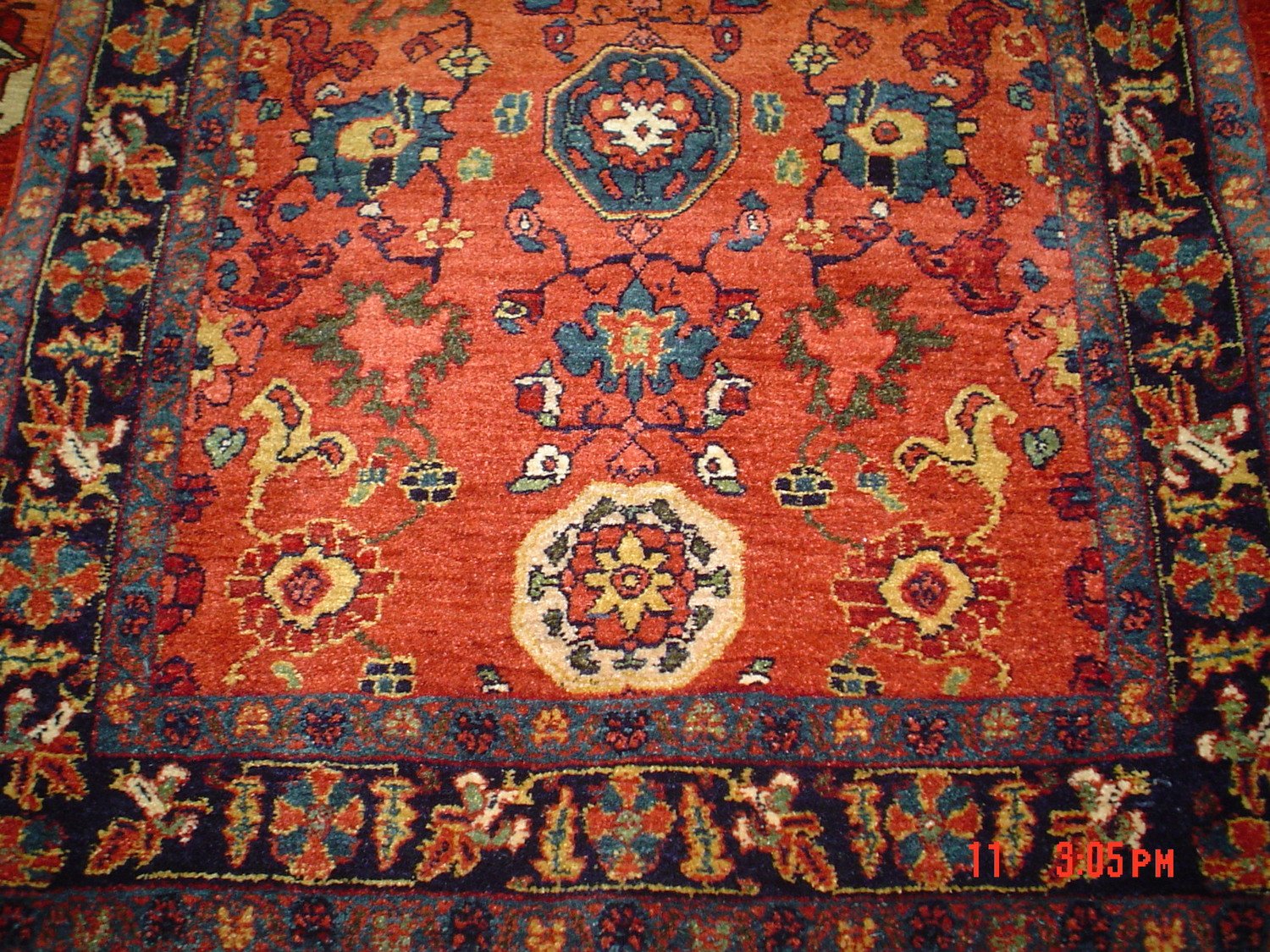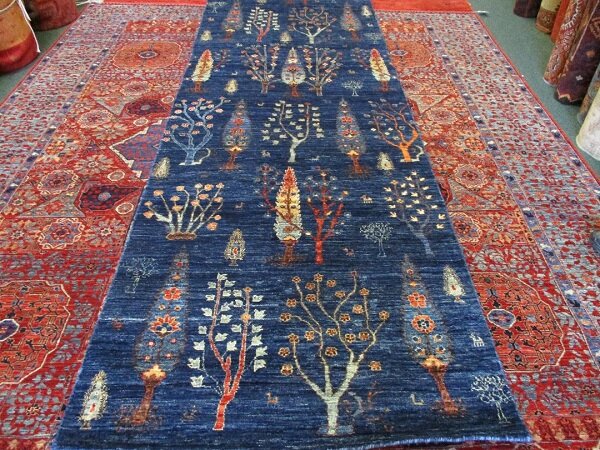Everything You Need to Know Handmade Runner Rugs! By Penny Krieger
What is a Runner?
I'll start with the basics. A runner is a rug that is much longer that it is wide and has classically been used in hallways and staircases in decorating interiors.
In the Oriental Rug industry, all rugs are handwoven. A machine-woven rug could still be a "runner rug" but as the title of this article denotes, I will be discussing mostly handmade, handwoven, or hand-knotted runners. Of course, my decorating tips can be used with any type of runner but I am an Oriental Rug retailer so all the photos in this article are of genuine Oriental rug runners or Persian runners.
Some of the terms used to refer to this type of runner are runner rugs, Persian runner, Oriental rug runner, handmade runner, handwoven runner, Turkish runner, antique runner, and Oriental rug runner. There are also runners referred to by their specific designs indicating a tribal affiliation. A few examples are Heriz runner, Bijar runner, Gabbeh runner, etc. These last few mentioned are somewhat well known and often featured in prominent Oriental rug websites. Last but not least there are kilim runners. (KELIM: A flat woven rug...Please see my Oriental rug dictionary!) Hopefully, I have not lost you!
The most durable and hard-wearing runners will be woven with good quality hand-spun wool and dyed with plant-based dyes. For a heavy traffic area, I recommend a runner with a "heavy" body. When you pick it up, it will have some weight to it, although these runners may not be the most tightly woven, they will wear very well. Good quality wool that has been hand-spun is very resistant to stains. Many runners produced in Afghanistan could be characterized as "hard wearing" and the heavier Persian Gabbehs and Bijars are almost indestructible, based on my experience.
Where are Some Good Places to Display Runners?
As a runner rug has a longer length than width, not only can it work well in hallways and staircases but many other spaces. One point that many people are unaware of is there are smaller runners as well as much longer ones, sometimes up to 20 ft. in length. An example of a smaller runner would be any runner under 6 ft. These smaller-sized runners are great on the side of a bed, at the end of a bed, in front of a bookcase, behind a sofa to name just a few spaces that could be interesting. I have a runner in my kitchen that sits on the opposite side of the kitchen island and looks wonderful. In my guest room, I have a smaller runner placed in front of a large dresser. The beauty of smaller rugs and runners is that if you decide to redecorate or just rearrange a few things, the smaller the rug, the more choices you will have as to where to place it. Yes, you can use a handwoven runner in a bathroom. They work well in front of a double sink and I have sold many for this purpose. Please see my article on How to Decorate With Oriental Rugs for more ideas.
When you are placing a runner in a hallway, does the runner have to extend the full length of the hallway? No, it does not. Just as you would not use a 3 ft. wide runner in a 3 ft wide hallway, the runner does not need to be the exact length of the hallway. Here is an example: Let’s say the hallway is 3 ft. wide and 12 ft. in length, placing a runner in this hallway that measured 2’7” or 2’8” in width with a length of 10 to 11 ft., give or take a few inches, would probably work just fine. It’s always nice to see a bit of space around any area rug or runner, never placing it edge to edge.
Here is an unusual but very effective use of a runner in a dining room of a craftsman home. Positioned on one side of the dining room table, this view can be seen from the living room and the runner works well as an invitation into the dining room.
What Runner Sizes are Available?
Most of the runners I've seen woven in the last few years are under 3 ft. in width and only here and there, have I come across a few wider pieces. Sizes that are abundantly available are runners measuring close 10 to 12 ft. in length. The widest runner I have seen in my career as an Oriental Rug retailer was 5 ft. in width. One would need a very wide hallway to accommodate such a piece and over the years many newer homes have hallways that are only 3 to 4 ft. in width. Runners that are extra wide and relatively long are called gallery-sized runners. I do have one such piece in my current inventory with a width of 4 ft. and a length of 15 ft. Although this photo does not depict the whole runner, you can get an idea of the design and colors. And yes, it is hand woven! This piece was woven in Afghanistan in the popular Tree of Life design. It is currently available at my rug gallery.
Here is another runner. This one was also woven in Afghanistan. I believe it was over 12 ft long. The width was just under 3 ft.
How Often Should I Wash or Clean my Handmade Runner?
Spots should be cleaned immediately using a clean damp washcloth. You can add a little white vinegar to a bowl of water, soak and wring out the washcloth and gently rug the soiled area. Always rub in the same direction of the pile. Rinse the washcloth and repeat, the last few times using only clean water. Blot with a dry towel and most spots should be easily removed. I do not recommend using any harsh chemical cleaners on an Oriental rug or runner. If this treatment is ineffective, it is best to take your rug to a reputable firm that specializes in washing Oriental rugs. As far as a general cleaning of handmade rugs and runners, it definitely depends on how much traffic you have in your home. A rug exposed to heavy use should get a good wash every few years and be vacuumed at least weekly.
Can I Wash a Runner Myself?
If the runner is under 10 ft. long, you can usually wash it yourself if you have a good space to do this which might be a large deck or patio and a place to hang the rug to dry. The exceptions to a do-it-yourself project are silk rugs, more formal, very finely woven rugs, and antique rugs. These types of rugs need a professional touch and may have issues that deserve a more skilled approach. I have written an article on how to wash an Oriental rug which you may find useful on my blog. Keep in mind that when you do wash your rug, hot weather is best so that the rug has a chance to dry quickly.
In summary, there are many beautiful and varied Oriental rug runners and Persian runners currently available in the Oriental rug market so if you are thinking about a purchase, please take a look at my gallery pages as I always have a very large selection of well made, interesting and beautiful handwoven Oriental rug runners!
Penny Krieger is the owner of Paradise Oriental Rugs, Inc., located in Walla Walla, WA. Specializing in genuine Persian rugs and tribal rugs from Iran and Afghanistan, the rugs in her gallery are now available on an appointment basis. She also ships rugs out of state to all locations in the US. Questions welcome, all prices on request. https://www.paradiseorientalrugs.com Phone: 707-823-3355




